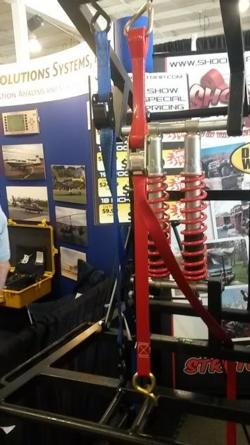Fri, Jul 24, 2015
The Claw And Shock Strap Offer Easy, Reliable Tiedowns
By Maria Morrison
In Wisconsin in late July, thunderstorms and high winds are a given. At AirVenture, where spacing between wingtips rarely exceeds two feet, one snapped tie down can result in a two or three aircraft pileup. Pilots will often leave the airshow periodically to make sure their planes are still attached to the ground. Fortunately, there are a few products and tips that allow pilots to enjoy their day instead of checking on their tie downs every five minutes.

Aircraft-to-ground attachments have two essential parts: the rope that is attached to the strut and the tie down that goes into the ground. The tie down can be anything that digs into the ground, but one of the most common is The Claw, the first product in a line by Millennium Outfitters.
The Claw has been exhibiting at AirVenture for the past ten years as a compactable tie down. It has three legs that produce individual stakes to be driven into the ground at angles so that they can not be pulled out. The Claw works on slopes and requires only good soil, grass or no grass.
The one key to tying down that those at The Claw booth had was to place the tie down straight down from where the rope attaches to the strut. If you attach your tie down to the rope it should hang directly below where the rope is attached. This way, the load is even on all three stakes. Those at The Claw also agree that the rope should not have too much tension, so that the wing can move with the wind a bit.
Although The Claw comes with a rope, there is a first-time exhibitor at AirVenture, Shock Strap, that offers a strap that moves with the airplane without letting go. Shock Strap is a polyester strap with a polyurethane piece that will absorb shock. As owner Fred Gill displays, the normal nylon strap comes off its tiedown when shaken up and down. Shock Strap, however, stayed on, with only the urethane piece moving. The Shock Strap comes in six, ten, and nineteen-foot sizes, and can withstand a load of up to 1500 lbs. Unlike nylon straps, which absorb water, the polyester strap repels water, and does not chafe.
More News
“This recognition was evident during the TBMOPA Annual Convention, where owners and operators clearly expressed their satisfaction with our focus on customer service, and enc>[...]
Overhead Maneuver A series of predetermined maneuvers prescribed for aircraft (often in formation) for entry into the visual flight rules (VFR) traffic pattern and to proceed to a >[...]
Aero Linx: Glenn H. Curtiss Museum The Glenn H. Curtiss Museum, bearing the name of Hammondsport’s favorite son, is located on State Route 54, one half mile south of the vill>[...]
The Flight Instructor Noticed Some Engine Roughness And Diverted Toward Westwinds Airport On November 2, 2025, about 1630 mountain standard time, an experimental amateur-built Just>[...]
From 2014 (YouTube Edition) -- Disclaimer: No Matter What He Tells You, Tom Is Not A Certified Firefighting Pilot While at EAA AirVenture 2014, ANN News Editor, Tom Patton checked >[...]
 Aero-News: Quote of the Day (11.20.25)
Aero-News: Quote of the Day (11.20.25) ANN's Daily Aero-Term (11.20.25): Overhead Maneuver
ANN's Daily Aero-Term (11.20.25): Overhead Maneuver ANN's Daily Aero-Linx (11.20.25)
ANN's Daily Aero-Linx (11.20.25) NTSB Prelim: Just Highlander
NTSB Prelim: Just Highlander Classic Aero-TV: Just Like The 'Real' Thing Redbird/Disneys Dusty FlightSim
Classic Aero-TV: Just Like The 'Real' Thing Redbird/Disneys Dusty FlightSim



